Auditing Case Study: Legal and Ethical Issues for OEV and Framed Ltd.
VerifiedAdded on 2022/08/26
|10
|2144
|13
Report
AI Summary
This report analyzes an auditing case involving OEV, an accounting firm, and Framed Ltd., a client company that experienced financial fraud. The case explores the tort of negligence by the auditor, specifically highlighting the failure to detect fraudulent activities committed by Framed Ltd.'s sales representatives. The report discusses the auditor's responsibilities, the concept of 'due professional care,' and the actions that can be taken against OEV for its negligence. The case also delves into an ethical dilemma faced by an OEV senior auditor, applying the American Accounting Association's decision-making process to evaluate alternative courses of action. The report concludes by emphasizing the importance of ethical decision-making in auditing and the potential consequences of failing to uphold professional standards, affecting stakeholders like the liquidator and a bank that relied on the audited financial reports. The report also discusses the ethical issues involved and the consequences of different actions.
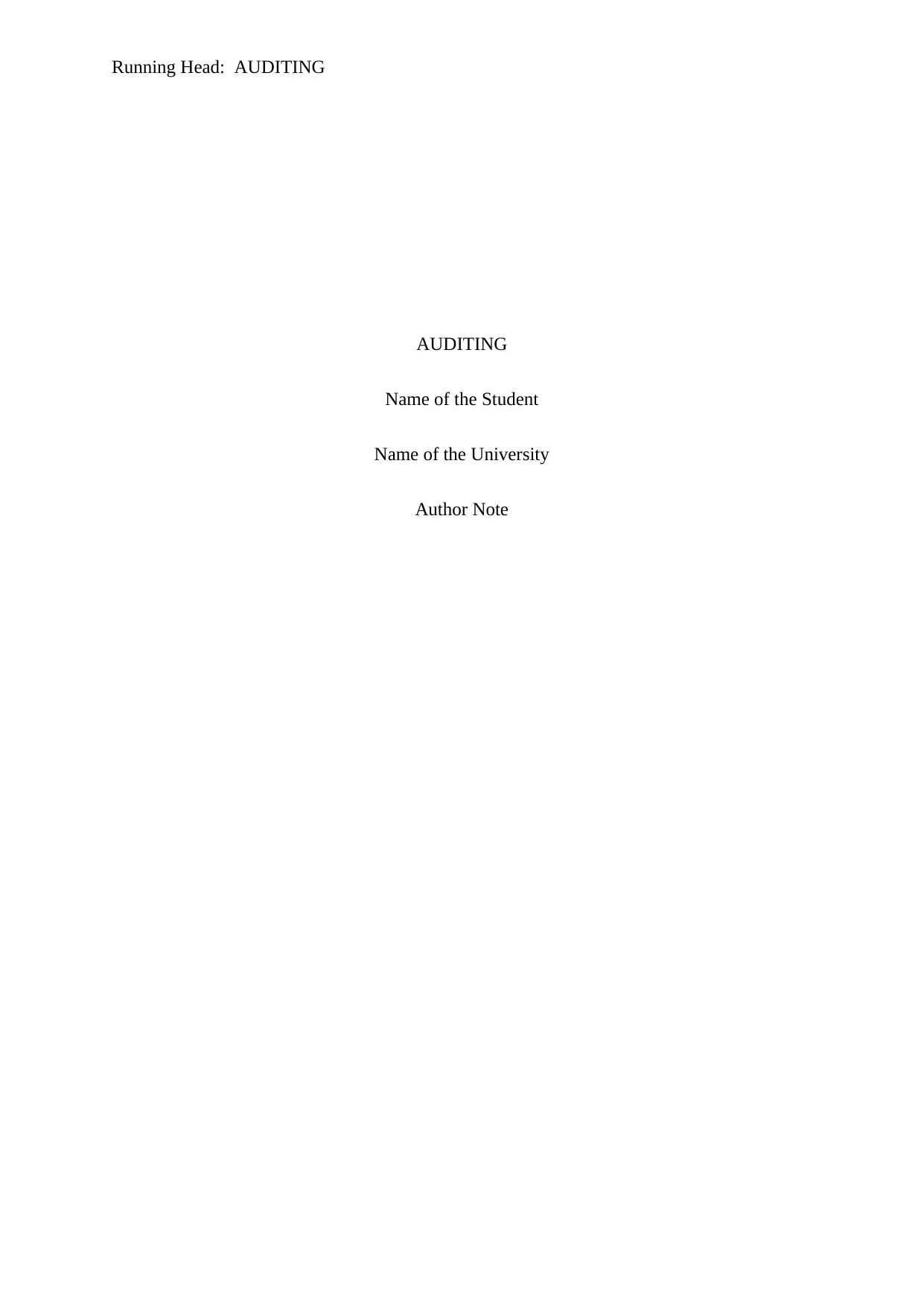
Running Head: AUDITING
AUDITING
Name of the Student
Name of the University
Author Note
AUDITING
Name of the Student
Name of the University
Author Note
Paraphrase This Document
Need a fresh take? Get an instant paraphrase of this document with our AI Paraphraser
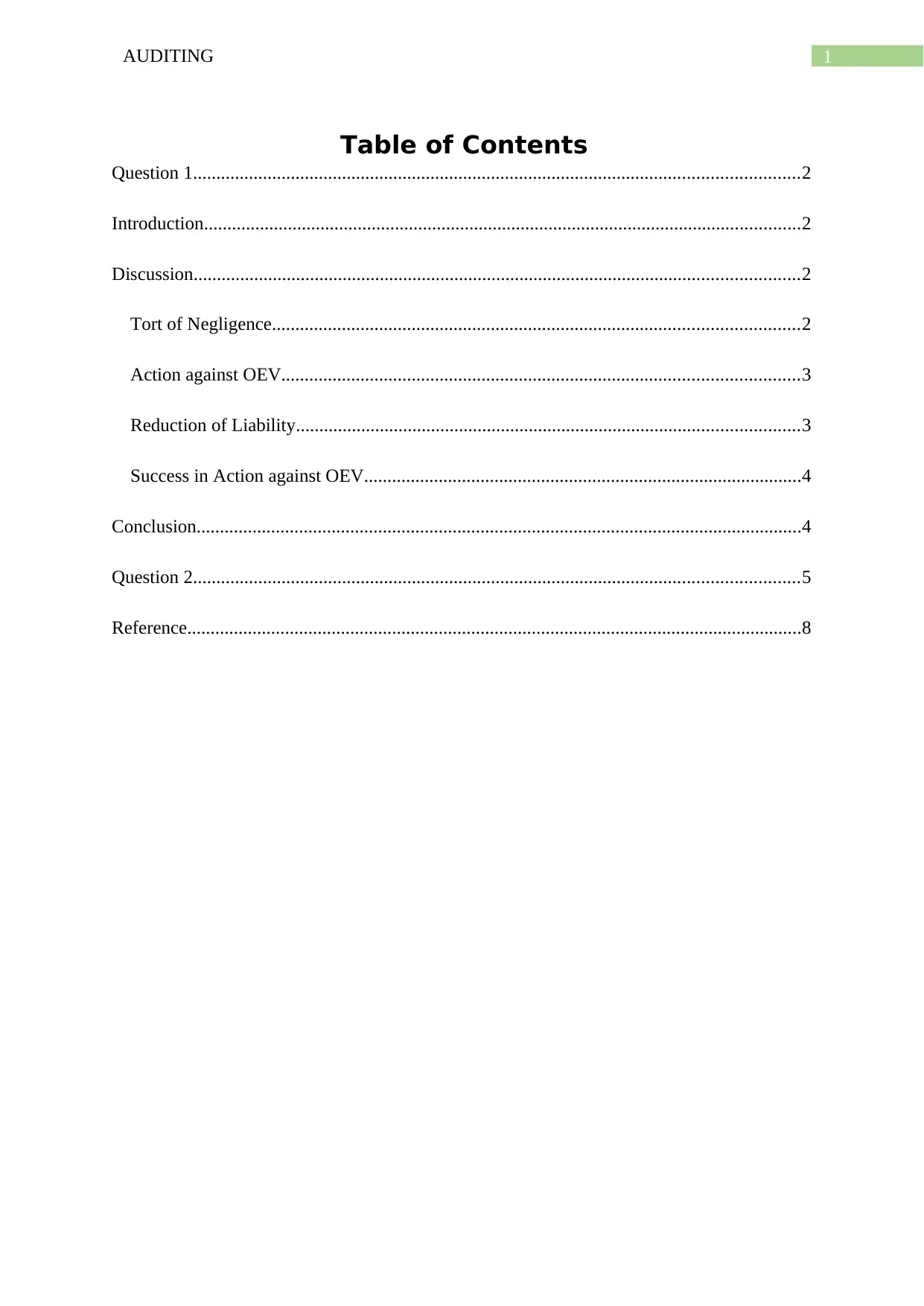
1AUDITING
Table of Contents
Question 1..................................................................................................................................2
Introduction................................................................................................................................2
Discussion..................................................................................................................................2
Tort of Negligence.................................................................................................................2
Action against OEV...............................................................................................................3
Reduction of Liability............................................................................................................3
Success in Action against OEV..............................................................................................4
Conclusion..................................................................................................................................4
Question 2..................................................................................................................................5
Reference....................................................................................................................................8
Table of Contents
Question 1..................................................................................................................................2
Introduction................................................................................................................................2
Discussion..................................................................................................................................2
Tort of Negligence.................................................................................................................2
Action against OEV...............................................................................................................3
Reduction of Liability............................................................................................................3
Success in Action against OEV..............................................................................................4
Conclusion..................................................................................................................................4
Question 2..................................................................................................................................5
Reference....................................................................................................................................8
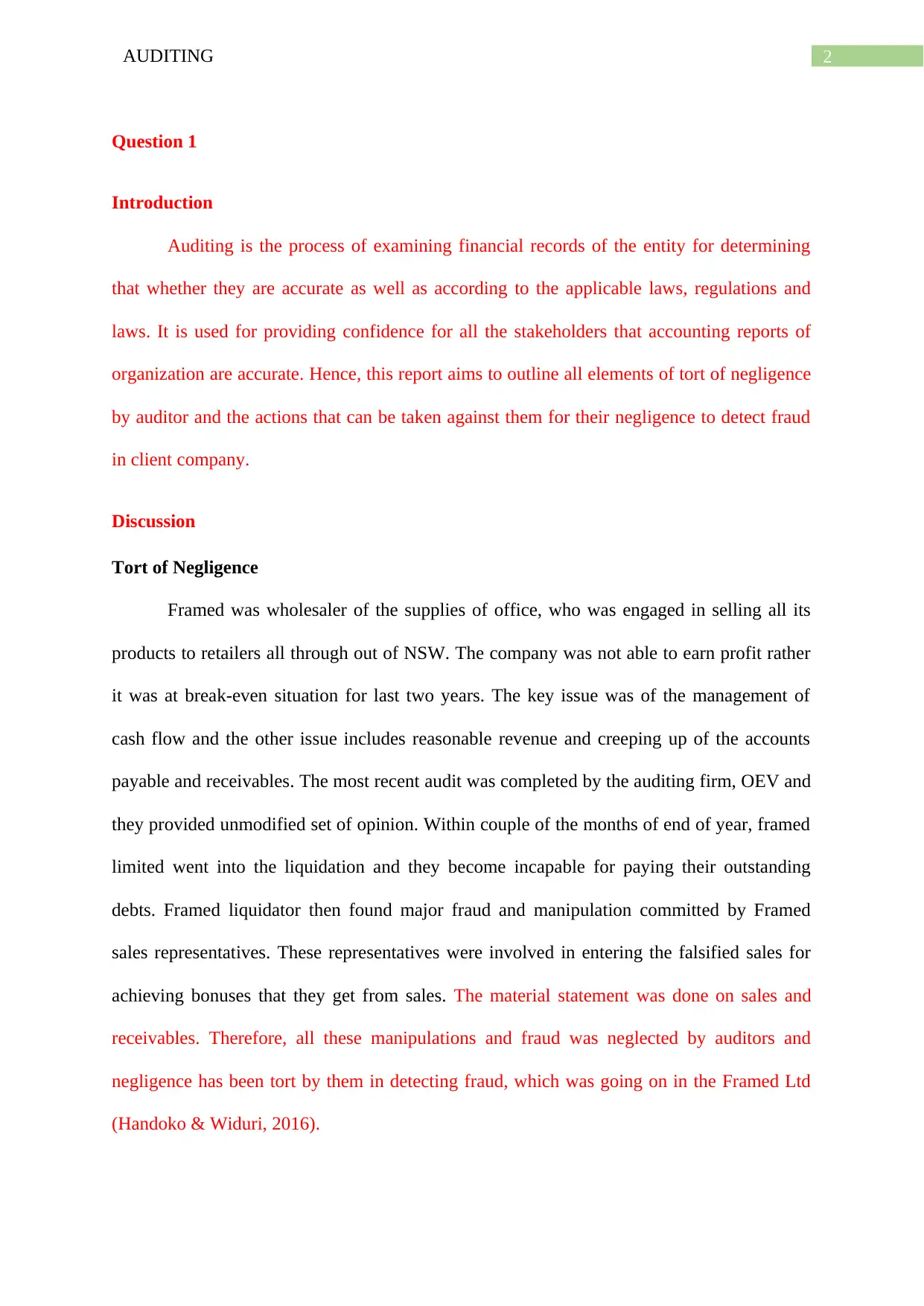
2AUDITING
Question 1
Introduction
Auditing is the process of examining financial records of the entity for determining
that whether they are accurate as well as according to the applicable laws, regulations and
laws. It is used for providing confidence for all the stakeholders that accounting reports of
organization are accurate. Hence, this report aims to outline all elements of tort of negligence
by auditor and the actions that can be taken against them for their negligence to detect fraud
in client company.
Discussion
Tort of Negligence
Framed was wholesaler of the supplies of office, who was engaged in selling all its
products to retailers all through out of NSW. The company was not able to earn profit rather
it was at break-even situation for last two years. The key issue was of the management of
cash flow and the other issue includes reasonable revenue and creeping up of the accounts
payable and receivables. The most recent audit was completed by the auditing firm, OEV and
they provided unmodified set of opinion. Within couple of the months of end of year, framed
limited went into the liquidation and they become incapable for paying their outstanding
debts. Framed liquidator then found major fraud and manipulation committed by Framed
sales representatives. These representatives were involved in entering the falsified sales for
achieving bonuses that they get from sales. The material statement was done on sales and
receivables. Therefore, all these manipulations and fraud was neglected by auditors and
negligence has been tort by them in detecting fraud, which was going on in the Framed Ltd
(Handoko & Widuri, 2016).
Question 1
Introduction
Auditing is the process of examining financial records of the entity for determining
that whether they are accurate as well as according to the applicable laws, regulations and
laws. It is used for providing confidence for all the stakeholders that accounting reports of
organization are accurate. Hence, this report aims to outline all elements of tort of negligence
by auditor and the actions that can be taken against them for their negligence to detect fraud
in client company.
Discussion
Tort of Negligence
Framed was wholesaler of the supplies of office, who was engaged in selling all its
products to retailers all through out of NSW. The company was not able to earn profit rather
it was at break-even situation for last two years. The key issue was of the management of
cash flow and the other issue includes reasonable revenue and creeping up of the accounts
payable and receivables. The most recent audit was completed by the auditing firm, OEV and
they provided unmodified set of opinion. Within couple of the months of end of year, framed
limited went into the liquidation and they become incapable for paying their outstanding
debts. Framed liquidator then found major fraud and manipulation committed by Framed
sales representatives. These representatives were involved in entering the falsified sales for
achieving bonuses that they get from sales. The material statement was done on sales and
receivables. Therefore, all these manipulations and fraud was neglected by auditors and
negligence has been tort by them in detecting fraud, which was going on in the Framed Ltd
(Handoko & Widuri, 2016).
⊘ This is a preview!⊘
Do you want full access?
Subscribe today to unlock all pages.

Trusted by 1+ million students worldwide
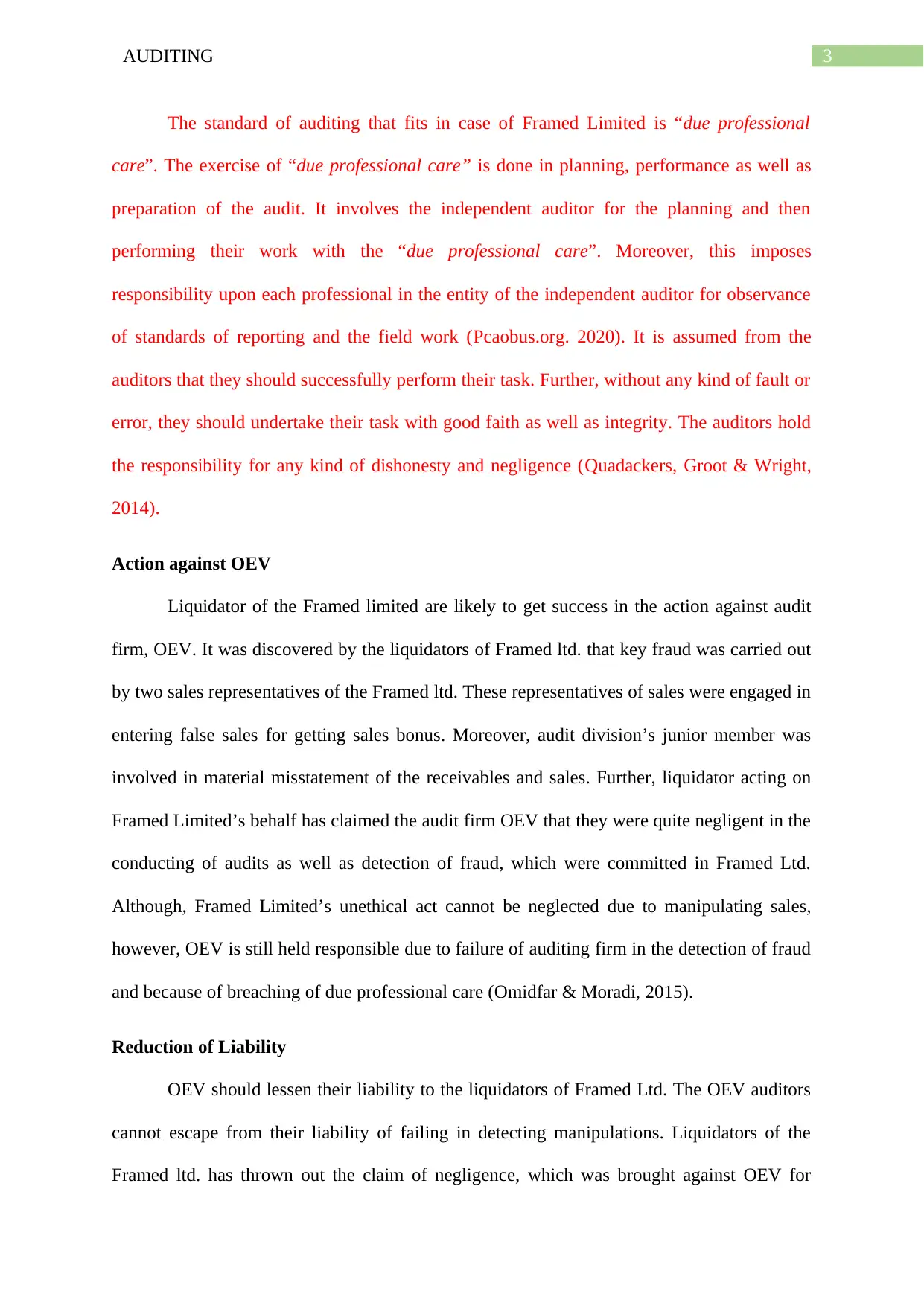
3AUDITING
The standard of auditing that fits in case of Framed Limited is “due professional
care”. The exercise of “due professional care” is done in planning, performance as well as
preparation of the audit. It involves the independent auditor for the planning and then
performing their work with the “due professional care”. Moreover, this imposes
responsibility upon each professional in the entity of the independent auditor for observance
of standards of reporting and the field work (Pcaobus.org. 2020). It is assumed from the
auditors that they should successfully perform their task. Further, without any kind of fault or
error, they should undertake their task with good faith as well as integrity. The auditors hold
the responsibility for any kind of dishonesty and negligence (Quadackers, Groot & Wright,
2014).
Action against OEV
Liquidator of the Framed limited are likely to get success in the action against audit
firm, OEV. It was discovered by the liquidators of Framed ltd. that key fraud was carried out
by two sales representatives of the Framed ltd. These representatives of sales were engaged in
entering false sales for getting sales bonus. Moreover, audit division’s junior member was
involved in material misstatement of the receivables and sales. Further, liquidator acting on
Framed Limited’s behalf has claimed the audit firm OEV that they were quite negligent in the
conducting of audits as well as detection of fraud, which were committed in Framed Ltd.
Although, Framed Limited’s unethical act cannot be neglected due to manipulating sales,
however, OEV is still held responsible due to failure of auditing firm in the detection of fraud
and because of breaching of due professional care (Omidfar & Moradi, 2015).
Reduction of Liability
OEV should lessen their liability to the liquidators of Framed Ltd. The OEV auditors
cannot escape from their liability of failing in detecting manipulations. Liquidators of the
Framed ltd. has thrown out the claim of negligence, which was brought against OEV for
The standard of auditing that fits in case of Framed Limited is “due professional
care”. The exercise of “due professional care” is done in planning, performance as well as
preparation of the audit. It involves the independent auditor for the planning and then
performing their work with the “due professional care”. Moreover, this imposes
responsibility upon each professional in the entity of the independent auditor for observance
of standards of reporting and the field work (Pcaobus.org. 2020). It is assumed from the
auditors that they should successfully perform their task. Further, without any kind of fault or
error, they should undertake their task with good faith as well as integrity. The auditors hold
the responsibility for any kind of dishonesty and negligence (Quadackers, Groot & Wright,
2014).
Action against OEV
Liquidator of the Framed limited are likely to get success in the action against audit
firm, OEV. It was discovered by the liquidators of Framed ltd. that key fraud was carried out
by two sales representatives of the Framed ltd. These representatives of sales were engaged in
entering false sales for getting sales bonus. Moreover, audit division’s junior member was
involved in material misstatement of the receivables and sales. Further, liquidator acting on
Framed Limited’s behalf has claimed the audit firm OEV that they were quite negligent in the
conducting of audits as well as detection of fraud, which were committed in Framed Ltd.
Although, Framed Limited’s unethical act cannot be neglected due to manipulating sales,
however, OEV is still held responsible due to failure of auditing firm in the detection of fraud
and because of breaching of due professional care (Omidfar & Moradi, 2015).
Reduction of Liability
OEV should lessen their liability to the liquidators of Framed Ltd. The OEV auditors
cannot escape from their liability of failing in detecting manipulations. Liquidators of the
Framed ltd. has thrown out the claim of negligence, which was brought against OEV for
Paraphrase This Document
Need a fresh take? Get an instant paraphrase of this document with our AI Paraphraser
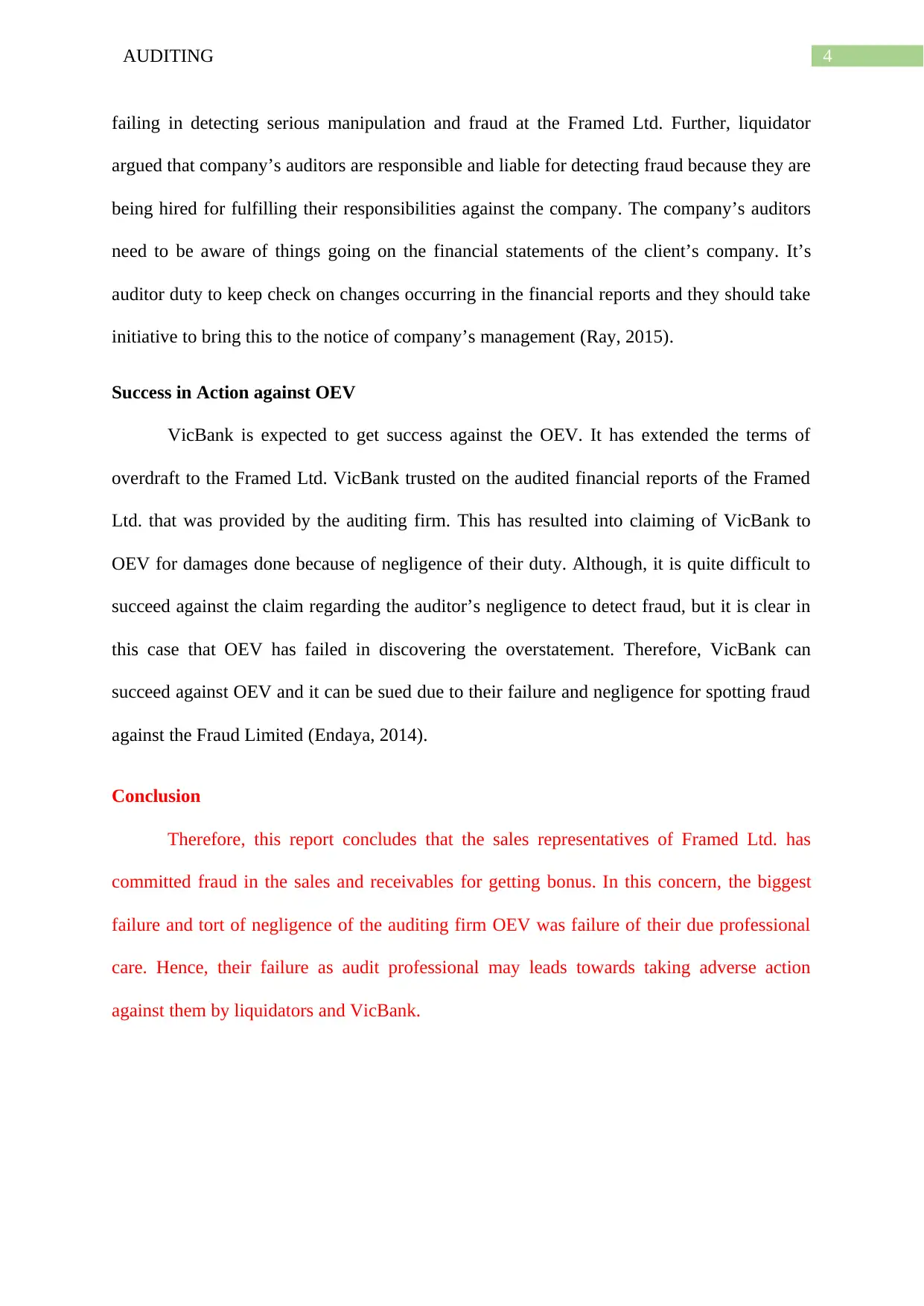
4AUDITING
failing in detecting serious manipulation and fraud at the Framed Ltd. Further, liquidator
argued that company’s auditors are responsible and liable for detecting fraud because they are
being hired for fulfilling their responsibilities against the company. The company’s auditors
need to be aware of things going on the financial statements of the client’s company. It’s
auditor duty to keep check on changes occurring in the financial reports and they should take
initiative to bring this to the notice of company’s management (Ray, 2015).
Success in Action against OEV
VicBank is expected to get success against the OEV. It has extended the terms of
overdraft to the Framed Ltd. VicBank trusted on the audited financial reports of the Framed
Ltd. that was provided by the auditing firm. This has resulted into claiming of VicBank to
OEV for damages done because of negligence of their duty. Although, it is quite difficult to
succeed against the claim regarding the auditor’s negligence to detect fraud, but it is clear in
this case that OEV has failed in discovering the overstatement. Therefore, VicBank can
succeed against OEV and it can be sued due to their failure and negligence for spotting fraud
against the Fraud Limited (Endaya, 2014).
Conclusion
Therefore, this report concludes that the sales representatives of Framed Ltd. has
committed fraud in the sales and receivables for getting bonus. In this concern, the biggest
failure and tort of negligence of the auditing firm OEV was failure of their due professional
care. Hence, their failure as audit professional may leads towards taking adverse action
against them by liquidators and VicBank.
failing in detecting serious manipulation and fraud at the Framed Ltd. Further, liquidator
argued that company’s auditors are responsible and liable for detecting fraud because they are
being hired for fulfilling their responsibilities against the company. The company’s auditors
need to be aware of things going on the financial statements of the client’s company. It’s
auditor duty to keep check on changes occurring in the financial reports and they should take
initiative to bring this to the notice of company’s management (Ray, 2015).
Success in Action against OEV
VicBank is expected to get success against the OEV. It has extended the terms of
overdraft to the Framed Ltd. VicBank trusted on the audited financial reports of the Framed
Ltd. that was provided by the auditing firm. This has resulted into claiming of VicBank to
OEV for damages done because of negligence of their duty. Although, it is quite difficult to
succeed against the claim regarding the auditor’s negligence to detect fraud, but it is clear in
this case that OEV has failed in discovering the overstatement. Therefore, VicBank can
succeed against OEV and it can be sued due to their failure and negligence for spotting fraud
against the Fraud Limited (Endaya, 2014).
Conclusion
Therefore, this report concludes that the sales representatives of Framed Ltd. has
committed fraud in the sales and receivables for getting bonus. In this concern, the biggest
failure and tort of negligence of the auditing firm OEV was failure of their due professional
care. Hence, their failure as audit professional may leads towards taking adverse action
against them by liquidators and VicBank.
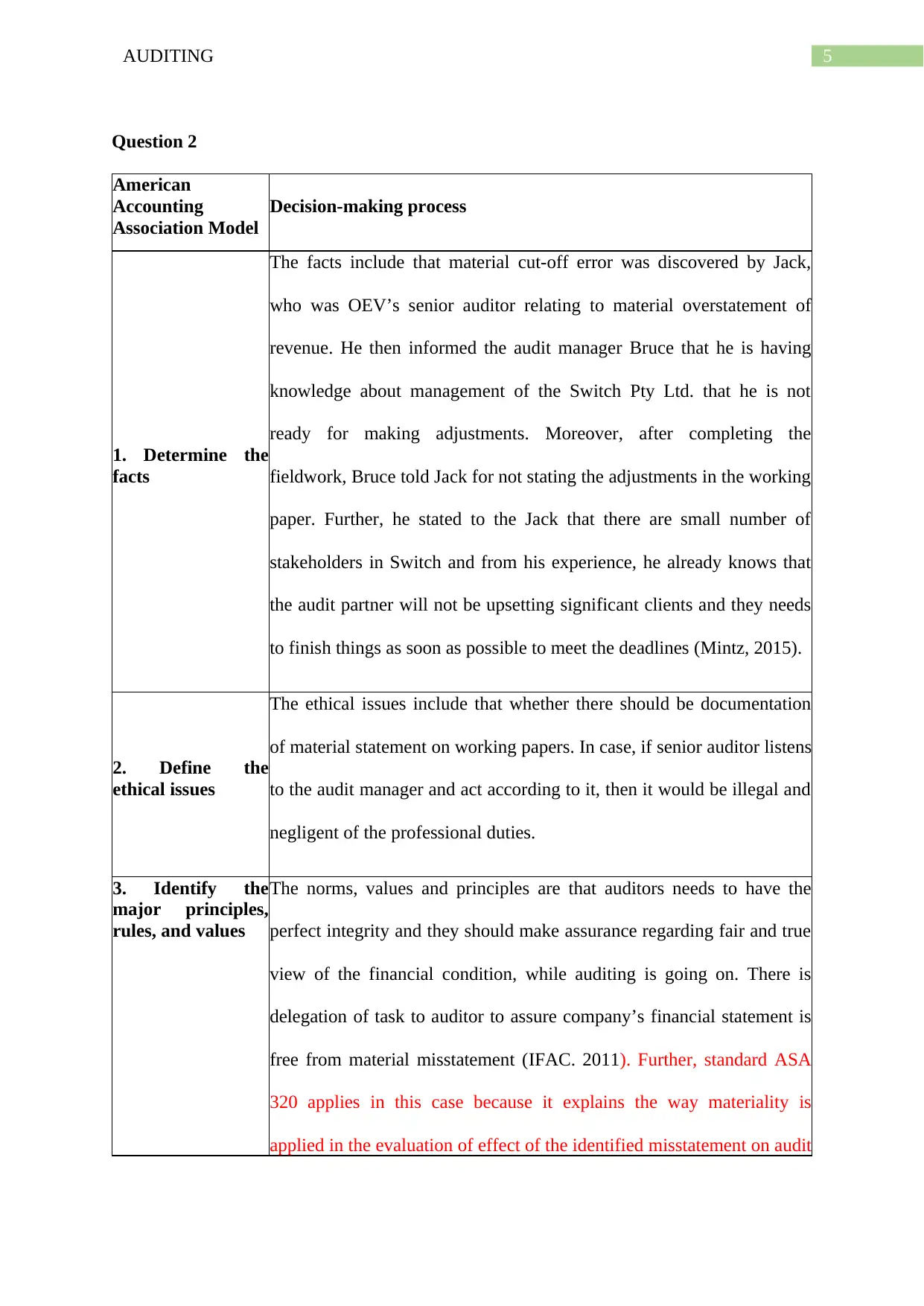
5AUDITING
Question 2
American
Accounting
Association Model
Decision-making process
1. Determine the
facts
The facts include that material cut-off error was discovered by Jack,
who was OEV’s senior auditor relating to material overstatement of
revenue. He then informed the audit manager Bruce that he is having
knowledge about management of the Switch Pty Ltd. that he is not
ready for making adjustments. Moreover, after completing the
fieldwork, Bruce told Jack for not stating the adjustments in the working
paper. Further, he stated to the Jack that there are small number of
stakeholders in Switch and from his experience, he already knows that
the audit partner will not be upsetting significant clients and they needs
to finish things as soon as possible to meet the deadlines (Mintz, 2015).
2. Define the
ethical issues
The ethical issues include that whether there should be documentation
of material statement on working papers. In case, if senior auditor listens
to the audit manager and act according to it, then it would be illegal and
negligent of the professional duties.
3. Identify the
major principles,
rules, and values
The norms, values and principles are that auditors needs to have the
perfect integrity and they should make assurance regarding fair and true
view of the financial condition, while auditing is going on. There is
delegation of task to auditor to assure company’s financial statement is
free from material misstatement (IFAC. 2011). Further, standard ASA
320 applies in this case because it explains the way materiality is
applied in the evaluation of effect of the identified misstatement on audit
Question 2
American
Accounting
Association Model
Decision-making process
1. Determine the
facts
The facts include that material cut-off error was discovered by Jack,
who was OEV’s senior auditor relating to material overstatement of
revenue. He then informed the audit manager Bruce that he is having
knowledge about management of the Switch Pty Ltd. that he is not
ready for making adjustments. Moreover, after completing the
fieldwork, Bruce told Jack for not stating the adjustments in the working
paper. Further, he stated to the Jack that there are small number of
stakeholders in Switch and from his experience, he already knows that
the audit partner will not be upsetting significant clients and they needs
to finish things as soon as possible to meet the deadlines (Mintz, 2015).
2. Define the
ethical issues
The ethical issues include that whether there should be documentation
of material statement on working papers. In case, if senior auditor listens
to the audit manager and act according to it, then it would be illegal and
negligent of the professional duties.
3. Identify the
major principles,
rules, and values
The norms, values and principles are that auditors needs to have the
perfect integrity and they should make assurance regarding fair and true
view of the financial condition, while auditing is going on. There is
delegation of task to auditor to assure company’s financial statement is
free from material misstatement (IFAC. 2011). Further, standard ASA
320 applies in this case because it explains the way materiality is
applied in the evaluation of effect of the identified misstatement on audit
⊘ This is a preview!⊘
Do you want full access?
Subscribe today to unlock all pages.

Trusted by 1+ million students worldwide
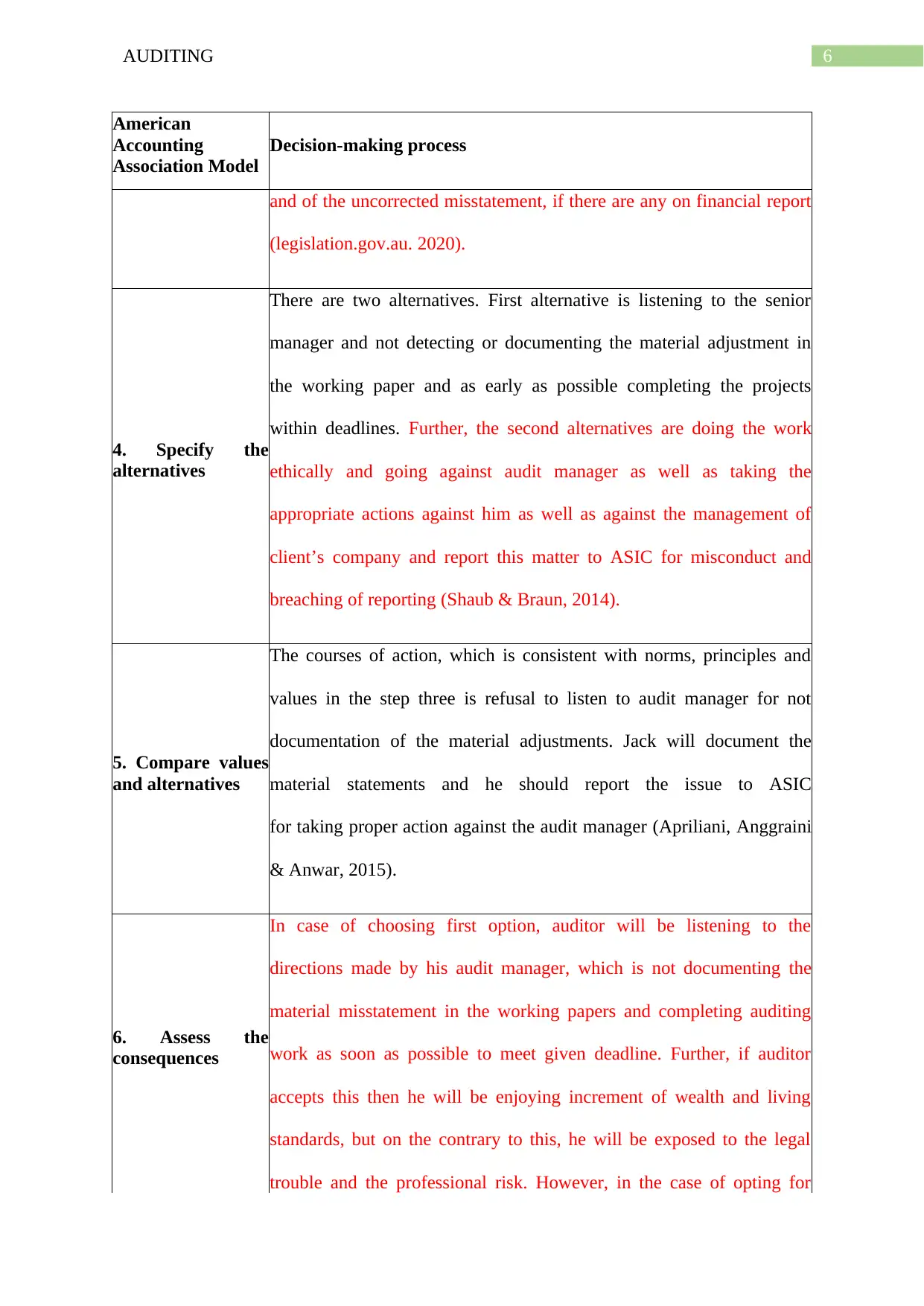
6AUDITING
American
Accounting
Association Model
Decision-making process
and of the uncorrected misstatement, if there are any on financial report
(legislation.gov.au. 2020).
4. Specify the
alternatives
There are two alternatives. First alternative is listening to the senior
manager and not detecting or documenting the material adjustment in
the working paper and as early as possible completing the projects
within deadlines. Further, the second alternatives are doing the work
ethically and going against audit manager as well as taking the
appropriate actions against him as well as against the management of
client’s company and report this matter to ASIC for misconduct and
breaching of reporting (Shaub & Braun, 2014).
5. Compare values
and alternatives
The courses of action, which is consistent with norms, principles and
values in the step three is refusal to listen to audit manager for not
documentation of the material adjustments. Jack will document the
material statements and he should report the issue to ASIC
for taking proper action against the audit manager (Apriliani, Anggraini
& Anwar, 2015).
6. Assess the
consequences
In case of choosing first option, auditor will be listening to the
directions made by his audit manager, which is not documenting the
material misstatement in the working papers and completing auditing
work as soon as possible to meet given deadline. Further, if auditor
accepts this then he will be enjoying increment of wealth and living
standards, but on the contrary to this, he will be exposed to the legal
trouble and the professional risk. However, in the case of opting for
American
Accounting
Association Model
Decision-making process
and of the uncorrected misstatement, if there are any on financial report
(legislation.gov.au. 2020).
4. Specify the
alternatives
There are two alternatives. First alternative is listening to the senior
manager and not detecting or documenting the material adjustment in
the working paper and as early as possible completing the projects
within deadlines. Further, the second alternatives are doing the work
ethically and going against audit manager as well as taking the
appropriate actions against him as well as against the management of
client’s company and report this matter to ASIC for misconduct and
breaching of reporting (Shaub & Braun, 2014).
5. Compare values
and alternatives
The courses of action, which is consistent with norms, principles and
values in the step three is refusal to listen to audit manager for not
documentation of the material adjustments. Jack will document the
material statements and he should report the issue to ASIC
for taking proper action against the audit manager (Apriliani, Anggraini
& Anwar, 2015).
6. Assess the
consequences
In case of choosing first option, auditor will be listening to the
directions made by his audit manager, which is not documenting the
material misstatement in the working papers and completing auditing
work as soon as possible to meet given deadline. Further, if auditor
accepts this then he will be enjoying increment of wealth and living
standards, but on the contrary to this, he will be exposed to the legal
trouble and the professional risk. However, in the case of opting for
Paraphrase This Document
Need a fresh take? Get an instant paraphrase of this document with our AI Paraphraser
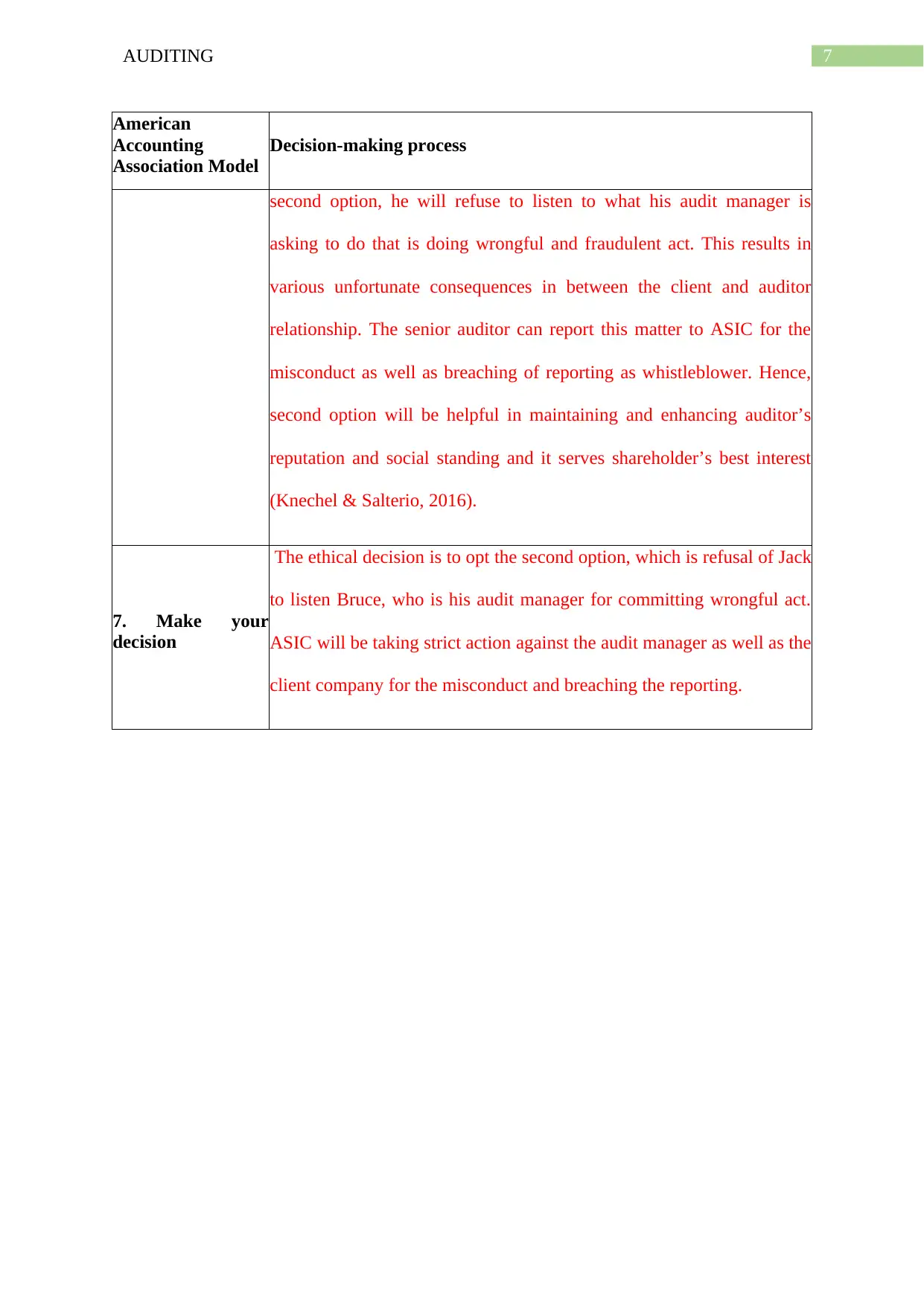
7AUDITING
American
Accounting
Association Model
Decision-making process
second option, he will refuse to listen to what his audit manager is
asking to do that is doing wrongful and fraudulent act. This results in
various unfortunate consequences in between the client and auditor
relationship. The senior auditor can report this matter to ASIC for the
misconduct as well as breaching of reporting as whistleblower. Hence,
second option will be helpful in maintaining and enhancing auditor’s
reputation and social standing and it serves shareholder’s best interest
(Knechel & Salterio, 2016).
7. Make your
decision
The ethical decision is to opt the second option, which is refusal of Jack
to listen Bruce, who is his audit manager for committing wrongful act.
ASIC will be taking strict action against the audit manager as well as the
client company for the misconduct and breaching the reporting.
American
Accounting
Association Model
Decision-making process
second option, he will refuse to listen to what his audit manager is
asking to do that is doing wrongful and fraudulent act. This results in
various unfortunate consequences in between the client and auditor
relationship. The senior auditor can report this matter to ASIC for the
misconduct as well as breaching of reporting as whistleblower. Hence,
second option will be helpful in maintaining and enhancing auditor’s
reputation and social standing and it serves shareholder’s best interest
(Knechel & Salterio, 2016).
7. Make your
decision
The ethical decision is to opt the second option, which is refusal of Jack
to listen Bruce, who is his audit manager for committing wrongful act.
ASIC will be taking strict action against the audit manager as well as the
client company for the misconduct and breaching the reporting.
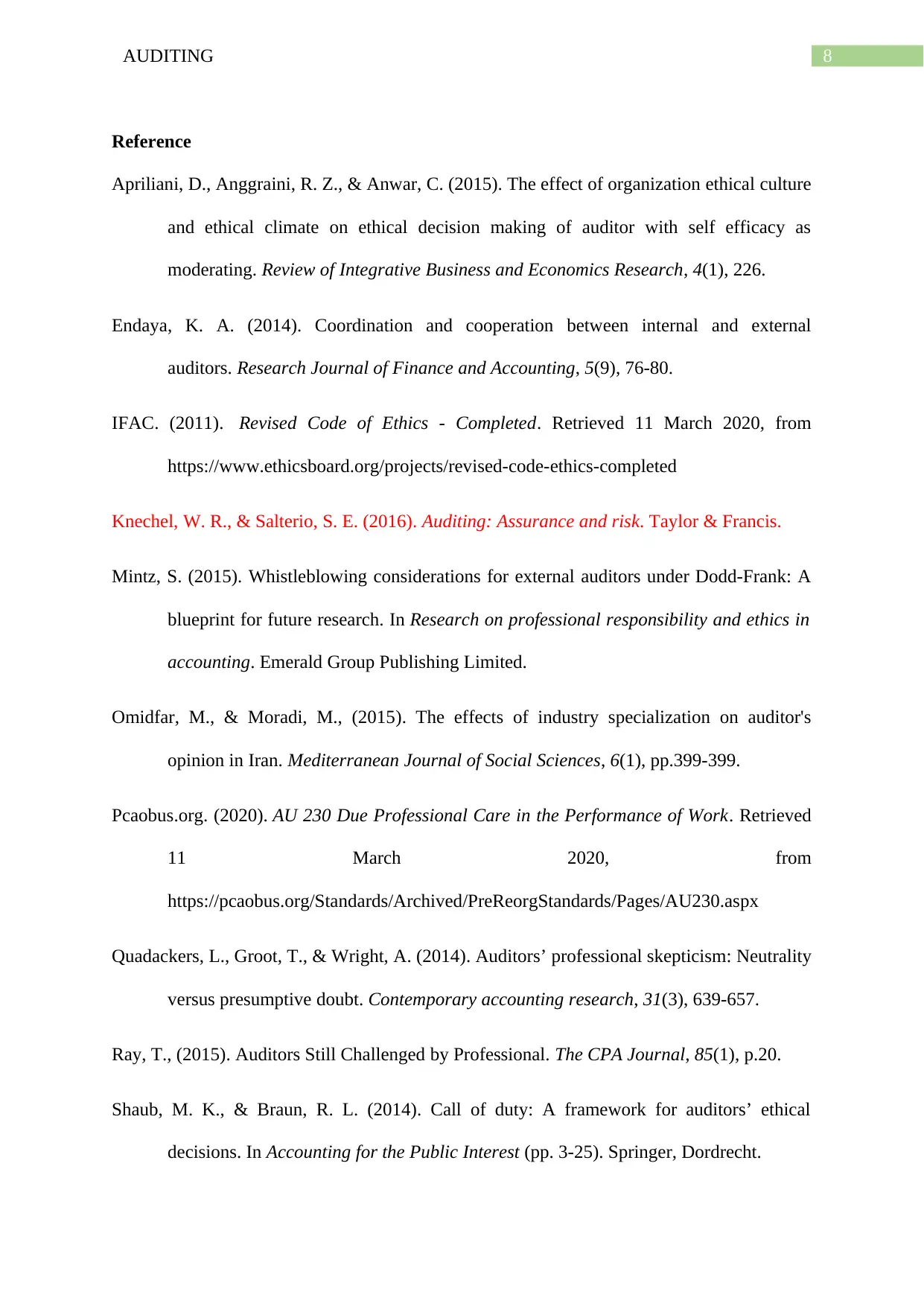
8AUDITING
Reference
Apriliani, D., Anggraini, R. Z., & Anwar, C. (2015). The effect of organization ethical culture
and ethical climate on ethical decision making of auditor with self efficacy as
moderating. Review of Integrative Business and Economics Research, 4(1), 226.
Endaya, K. A. (2014). Coordination and cooperation between internal and external
auditors. Research Journal of Finance and Accounting, 5(9), 76-80.
IFAC. (2011). Revised Code of Ethics - Completed. Retrieved 11 March 2020, from
https://www.ethicsboard.org/projects/revised-code-ethics-completed
Knechel, W. R., & Salterio, S. E. (2016). Auditing: Assurance and risk. Taylor & Francis.
Mintz, S. (2015). Whistleblowing considerations for external auditors under Dodd-Frank: A
blueprint for future research. In Research on professional responsibility and ethics in
accounting. Emerald Group Publishing Limited.
Omidfar, M., & Moradi, M., (2015). The effects of industry specialization on auditor's
opinion in Iran. Mediterranean Journal of Social Sciences, 6(1), pp.399-399.
Pcaobus.org. (2020). AU 230 Due Professional Care in the Performance of Work. Retrieved
11 March 2020, from
https://pcaobus.org/Standards/Archived/PreReorgStandards/Pages/AU230.aspx
Quadackers, L., Groot, T., & Wright, A. (2014). Auditors’ professional skepticism: Neutrality
versus presumptive doubt. Contemporary accounting research, 31(3), 639-657.
Ray, T., (2015). Auditors Still Challenged by Professional. The CPA Journal, 85(1), p.20.
Shaub, M. K., & Braun, R. L. (2014). Call of duty: A framework for auditors’ ethical
decisions. In Accounting for the Public Interest (pp. 3-25). Springer, Dordrecht.
Reference
Apriliani, D., Anggraini, R. Z., & Anwar, C. (2015). The effect of organization ethical culture
and ethical climate on ethical decision making of auditor with self efficacy as
moderating. Review of Integrative Business and Economics Research, 4(1), 226.
Endaya, K. A. (2014). Coordination and cooperation between internal and external
auditors. Research Journal of Finance and Accounting, 5(9), 76-80.
IFAC. (2011). Revised Code of Ethics - Completed. Retrieved 11 March 2020, from
https://www.ethicsboard.org/projects/revised-code-ethics-completed
Knechel, W. R., & Salterio, S. E. (2016). Auditing: Assurance and risk. Taylor & Francis.
Mintz, S. (2015). Whistleblowing considerations for external auditors under Dodd-Frank: A
blueprint for future research. In Research on professional responsibility and ethics in
accounting. Emerald Group Publishing Limited.
Omidfar, M., & Moradi, M., (2015). The effects of industry specialization on auditor's
opinion in Iran. Mediterranean Journal of Social Sciences, 6(1), pp.399-399.
Pcaobus.org. (2020). AU 230 Due Professional Care in the Performance of Work. Retrieved
11 March 2020, from
https://pcaobus.org/Standards/Archived/PreReorgStandards/Pages/AU230.aspx
Quadackers, L., Groot, T., & Wright, A. (2014). Auditors’ professional skepticism: Neutrality
versus presumptive doubt. Contemporary accounting research, 31(3), 639-657.
Ray, T., (2015). Auditors Still Challenged by Professional. The CPA Journal, 85(1), p.20.
Shaub, M. K., & Braun, R. L. (2014). Call of duty: A framework for auditors’ ethical
decisions. In Accounting for the Public Interest (pp. 3-25). Springer, Dordrecht.
⊘ This is a preview!⊘
Do you want full access?
Subscribe today to unlock all pages.

Trusted by 1+ million students worldwide
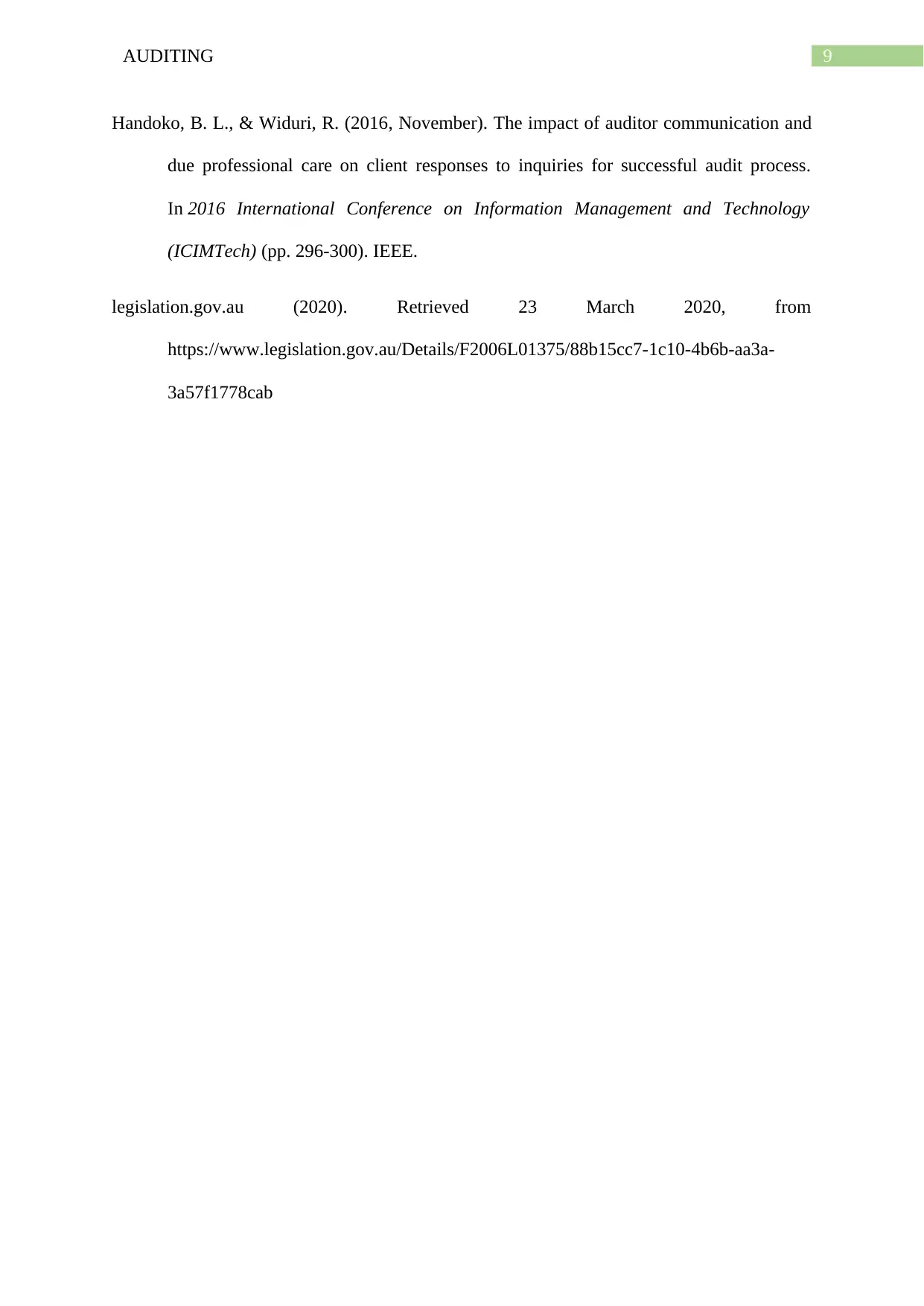
9AUDITING
Handoko, B. L., & Widuri, R. (2016, November). The impact of auditor communication and
due professional care on client responses to inquiries for successful audit process.
In 2016 International Conference on Information Management and Technology
(ICIMTech) (pp. 296-300). IEEE.
legislation.gov.au (2020). Retrieved 23 March 2020, from
https://www.legislation.gov.au/Details/F2006L01375/88b15cc7-1c10-4b6b-aa3a-
3a57f1778cab
Handoko, B. L., & Widuri, R. (2016, November). The impact of auditor communication and
due professional care on client responses to inquiries for successful audit process.
In 2016 International Conference on Information Management and Technology
(ICIMTech) (pp. 296-300). IEEE.
legislation.gov.au (2020). Retrieved 23 March 2020, from
https://www.legislation.gov.au/Details/F2006L01375/88b15cc7-1c10-4b6b-aa3a-
3a57f1778cab
1 out of 10
Related Documents
Your All-in-One AI-Powered Toolkit for Academic Success.
+13062052269
info@desklib.com
Available 24*7 on WhatsApp / Email
![[object Object]](/_next/static/media/star-bottom.7253800d.svg)
Unlock your academic potential
Copyright © 2020–2025 A2Z Services. All Rights Reserved. Developed and managed by ZUCOL.





